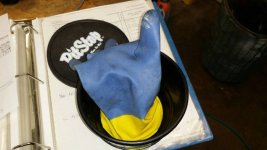FWIW during the OPEC embargo (1979-ish) we had gasoline rationing, in Calif anyway.
You could fill up every other day, based on your license plate number, and there was always long lines.
I owned an older Chevy pickup with saddle tanks. The tanks had not been used in a long time,
but I figured they were just the thing to get me through the no-gas days.
I'd fill the aux tanks, then run them dry before switching to the mains (just like an airplane).
Well, like I said, the saddle tanks hadn't been used in a long time--
every time I ran them dry, it would suck out debris from the bottom of the tank which would clog the finger screen at the carb inlet.
I got pretty good at leaping out of the cab, opening the hood, and removing/shaking clear/reinstalling that screen...
all while people were yelling and honking at me to get out of the way.
Bottom line is, you don't want that happening in the air.









